Where Are Autonomous Cars Right Now? Four Systems Tested
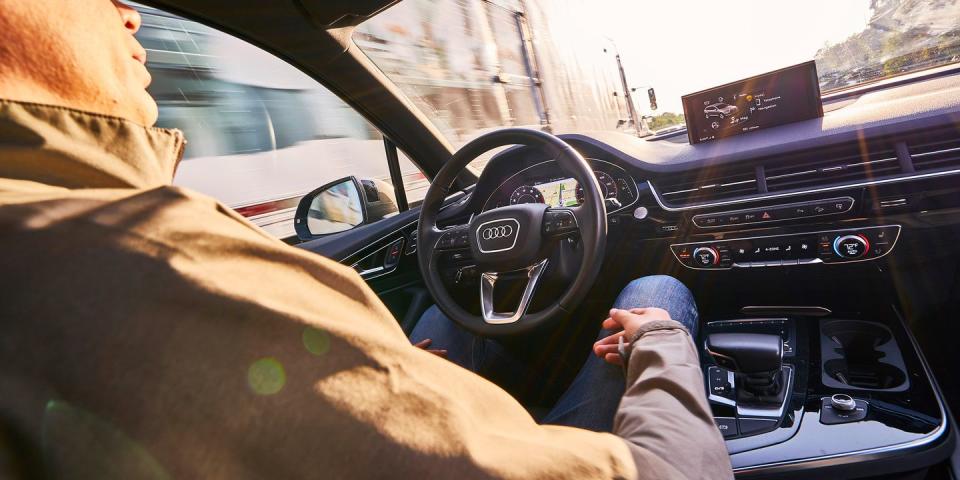
Let’s make one thing clear up front: Until now, no automaker has endorsed drivers removing their hands from the steering wheel. The steering assists that have proliferated in recent years are all padded with liability disclaimers and hand-sensing algorithms that admonish drivers if they stop maintaining contact with the wheel. Yes, this is true even of Tesla’s Autopilot, regardless of what you may have seen on YouTube. A can of Red Bull taped to the steering wheel as a substitute for a human hand is not a hack. It’s a flaw in human intelligence.
In October, Cadillac claimed a notable first in the automation arms race when its truly hands-free Super Cruise technology reached showrooms. Available on the CT6, Super Cruise enables the car to sail down divided, limited-access highways at speeds up to 85 mph for as long as the driver’s chosen lane lasts, no hands or energy-drink cans required. While Super Cruise represents the leading edge of partially automated technology in today’s production cars, it reflects only one company’s approach, and at $71,290 for the cheapest CT6 with the feature, it won’t change driving for the masses. The 2019 Audi A8, due in the United States this spring, has the potential to advance the game to Level 3, allowing drivers to take both their hands off the wheel and their eyes off the road with its Traffic Jam Pilot. However, the company remains uncertain if it will enable the technology in the U.S. due to regulatory and liability concerns.
For a broad read of the current state of these technologies, we slipped behind the steering wheels of four vehicles on sale today and then handed control to the computers. These vehicles—a Tesla Model S with the company’s second-generation system known as Enhanced Autopilot, a Honda Civic with Honda Sensing, an Audi Q7 with Traffic Jam Assist, and the Super Cruisin’ Caddy—represent a spectrum of philosophies, prices, and capabilities. A comparison test pitting the vehicles against one another was guaranteed to force some systems out of context. Instead, we evaluated the systems individually and according to their intended uses. And while we admit to taking our hands off the wheel in every vehicle, we insist it was only done in the service of journalism.
Tesla Enhanced Autopilot (Level 2)
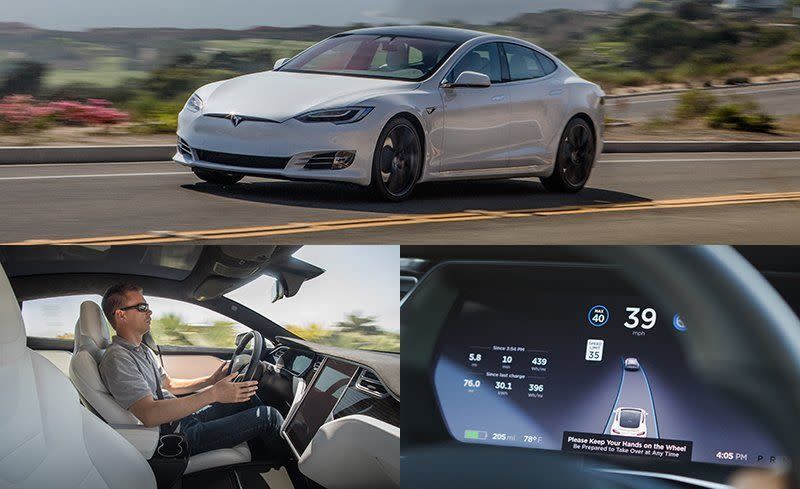
A year after its debut, Tesla’s Enhanced Autopilot still offers no perceivable enhancement over the first-generation Autopilot. Compared with the original, the second-generation hardware suite employs four times as many cameras, ultrasonic sensors with double the range, and 40 times the computing power, yet Enhanced Autopilot shipped in October 2016 without fundamental abilities such as self-steering and adaptive cruise control because Tesla was still developing the software. All the sensors in the world can’t guide a car if the computer can’t make sense of the world, and Tesla took a temporary backward step when it brought Autopilot development in-house after an ugly public breakup with Mobileye, the supplier behind the original Autopilot.
By this past August, when we shepherded a $146,200 Model S P100D around Southern California, Enhanced Autopilot operated at the same level as the first-gen system, both according to Tesla and our own observations. The self-steering algorithm is no more certain or reliable than the earlier version we lived with in our long-term 2015 Tesla Model S. The technology that oozed possibility two years ago now simply feels incomplete, especially since Enhanced Autopilot makes the same unsettling mistakes as its predecessor did—mistakes that suggest a Tesla can’t always make sense of its environment.
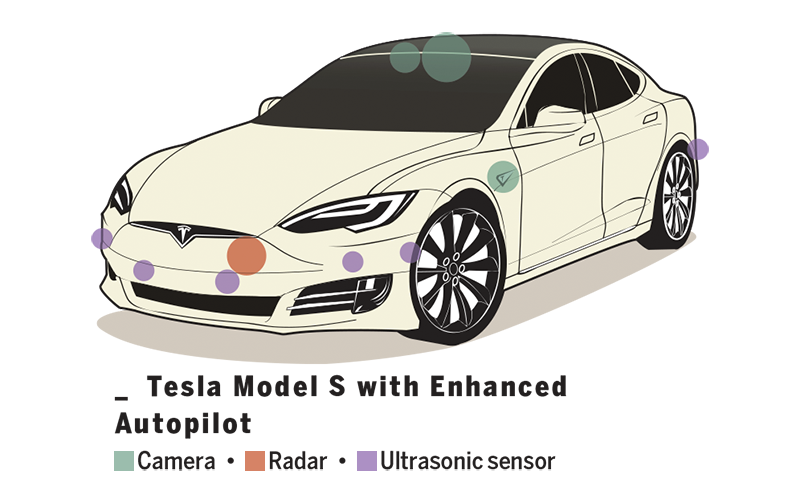
Autopilot can cover hundreds of miles flawlessly or it can make a dozen errors in as many miles. In either case, we’re always caught off guard when the system makes an abrupt steering input that attempts to yank the Model S out of its lane without warning. These errors appear to occur when Autopilot becomes confused about where the lane markers lie, either due to a groove in the road, a worn lane line, or the intentional interruption of markers when lanes merge and split. A firm grip on the steering wheel is usually enough to keep the car in its lane and disable Autopilot in these instances, but an inattentive driver can find himself making an involuntary lane change. A better solution would be to simply hand control back to the driver.
The enhancements are coming, and we’re told the current “beta” system will eventually evolve into Level 3 tech for highway driving. The company also promises that the sensors it installs in every new car it builds—eight cameras, a forward-facing radar, and 12 ultrasonic sensors—will be enough for Level 5 go-anywhere, hands-free automation with a software update. “You can absolutely be superhuman with just cameras,” CEO Elon Musk claims.
But even a mediocre human still has an advantage over today’s Autopilot. The cameras can’t don sunglasses, flip a visor down, stretch a hand out, or crane a neck to cope with the glare when the evening sun dips toward the horizon. Pointed west, the car ping-pongs within its lane as it sniffs for the markers. Later, darkness paints over the grooves, cracks, and faded remnants of no-longer-used lane lines that are Autopilot’s kryptonite. With less noise to filter out, the Model S centers itself in its lane and glides down the 101 as smoothly as we’ve ever experienced.
Honda Sensing (Level 1)
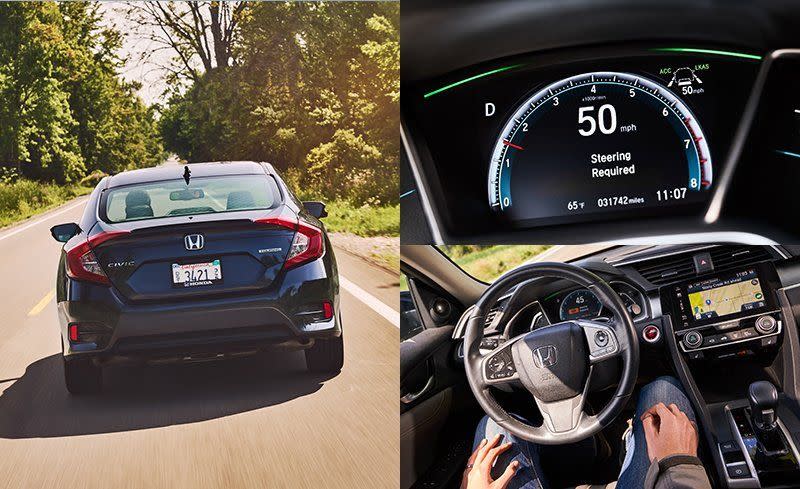
There will be no automation revolution as long as the technology is priced for the coastal crust. As a $1000 add-on (and even standard on certain models), Honda Sensing sells for one-fifth of Tesla’s Autopilot option, and it can be had on a Civic LX sedan at a price as low as $21,415.
With limited authority to make steering inputs, Honda’s suite behaves more like a driver-assistance feature than a partially automated system. Still, Honda Sensing stands out among other affordably priced alternatives because it performs lane centering, a more graceful variation of the lane-keeping assists that typically kick in with imprecise steering inputs only as a vehicle is about to leave its lane. The Civic Touring we drove traced a steady line on straight sections of highway with the driver offering only a limp handshake to the wheel. Yet Honda Sensing only nudges the steering wheel in the right direction when the road bends, and the driver must add more lock at turn-in to keep the car from running wide.
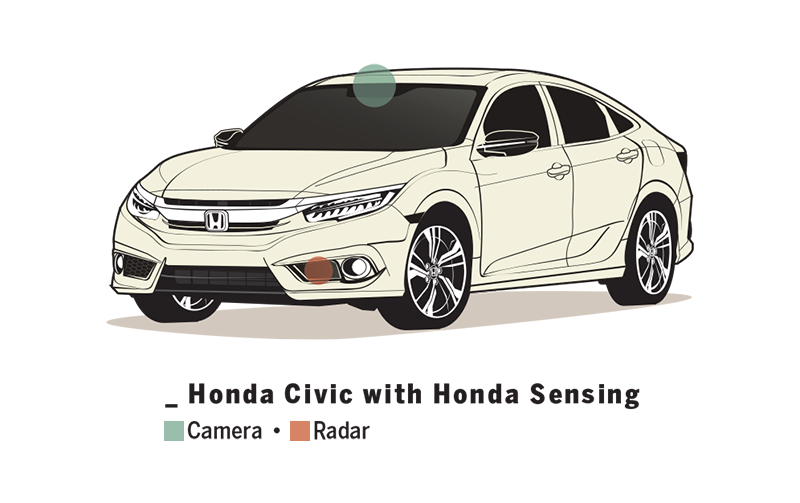
It’s a similar situation with Honda’s adaptive cruise control: If you don’t play an active role in the driving, you stand to be burned. While most industry players have mastered radar cruise control, Honda’s system occasionally fails to register the appropriate bogey from which to base its speed when vehicles change lanes. Around gradual bends, Honda Sensing can fail to spot the car it’s closing on until the Civic is practically on top of it. And in the hairiest scenarios, the system doesn’t always brake hard enough to avoid a collision. It’s up to the driver to intervene or else end up in someone’s trunk. And while Honda Sensing routinely does bring the vehicle to a stop in the normal flow of traffic, the adaptive cruise control requires the driver to tap the right pedal or the RES button to accelerate again.
Are these technical limitations or a product of risk-averse Japanese culture? Do the Honda’s shortcomings stem from inexperience or a conscious acknowledgment that the more adept the self-steering system, the more likely it is to inspire false confidence? The low-cost Honda Sensing system gives us the feeling that all these factors are in play here.
Audi Traffic Jam Assist (Level 2)
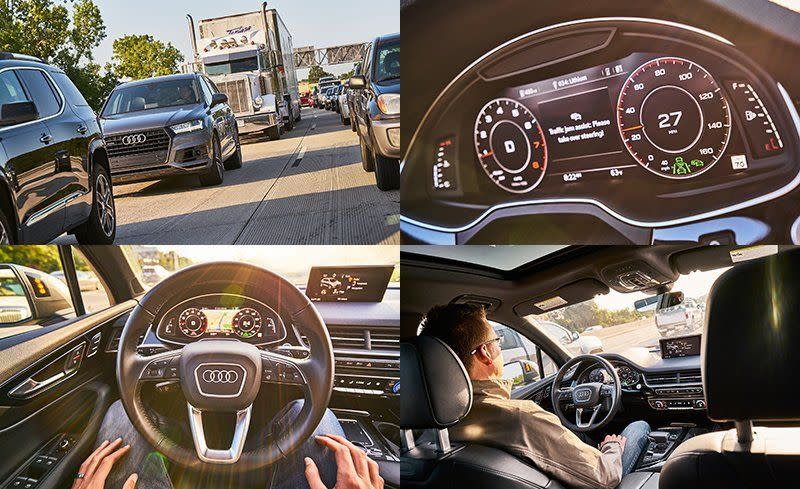
Taking the misery out of masochistic commutes is the killer app for budding automation. The relatively orderly highway environment constrains the technical problem while the low speeds of congestion minimize the risks if things go awry. That’s exactly the philosophy behind Audi’s Traffic Jam Assist, which is intended for use on limited-access roads when traffic drags below 40 mph. Those restrictions reduce the system’s usefulness if you’re crossing Middle America, but anyone who has braved L.A.’s 405 at 5:00 p.m. recognizes the value in relieving the driver from the grinding tedium of a rush-hour slog.
Scanning the world with a single camera behind the windshield and two radar sensors in the lower fascia, Traffic Jam Assist manages speed and steering, choosing its path by considering both the lane markings and the vehicle ahead of it. We sampled Audi’s tech in a $75,655 Q7 on Michigan freeways snarled by construction and the morning rush in the kind of stop-and-go that has every driver staring into his or her lap. With Traffic Jam Assist effortlessly gliding along, the magnetic suck of an idle smartphone is even stronger, but Audi expects the driver to remain alert with hands on the steering wheel. The system allows the driver just eight seconds of hands-off time before the chimes start and, if the driver doesn’t resume control, slows the vehicle to a stop 10 seconds later.
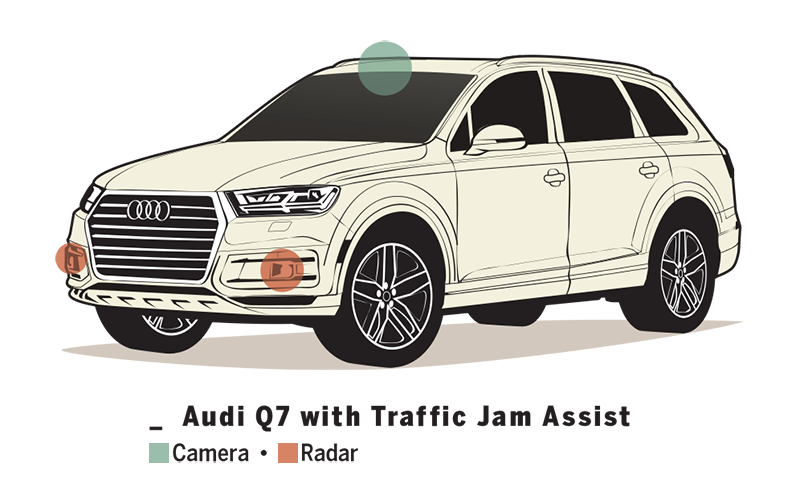
The 2019 A8 will silence the steering nanny and evolve Traffic Jam Assist into Traffic Jam Pilot—it’s just a matter of whether or not that technology is enabled. In markets where Traffic Jam Pilot is turned on, Audi will likely be the first automaker with Level 3 technology in production. That permits not only hands-free driving but eyes-off-the-road operation during highway traffic jams. Audi will even allow the driver to watch videos on the car’s infotainment display when the system is active. That’s preferable to napping because Traffic Jam Pilot needs the driver on standby to merge when the lane ends, steer around a disabled vehicle, or take control when traffic accelerates beyond 37 mph. This relatively low speed limit assures the lawyers that the computer can identify any showstoppers with enough time to alert the driver and safely hand over control—or, at the very least, bring the vehicle to a stop in traffic conditions where such behavior wouldn’t be totally unexpected.
Turning up the speed is the next logical move, but doing so exacerbates the hand-off problem that makes many automakers reluctant to introduce Level 3 automation for open-road driving. A car covers more than 100 feet every second at 70 mph, and any system that relies on a human to step in to solve the edge-case scenarios that stump the computer will have to provide adequate warning time for the driver to orient himself and understand the situation.
Cadillac Super Cruise (Level 2)
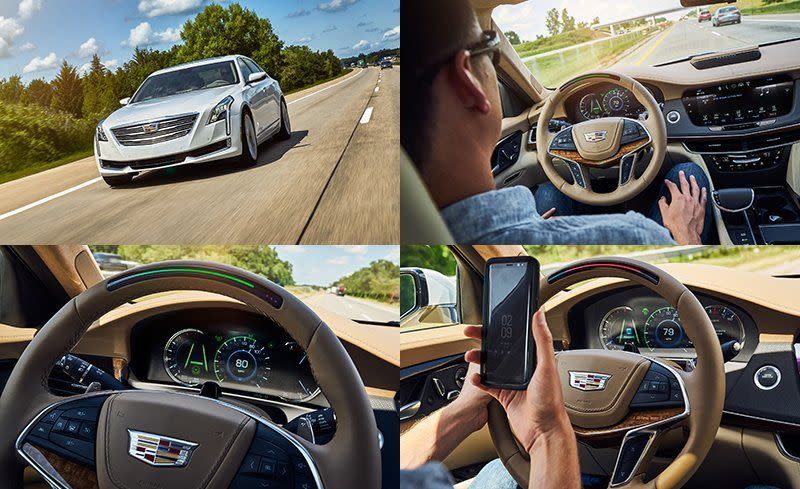
While Super Cruise’s maximum speed matches the speed limit of America’s fastest highways, it steers around the hand-off problem by forcing the driver to keep his eyes on the road. Super Cruise remains a Level 2 technology for this specific reason; Cadillac requires the driver to maintain vigilance, scanning for hazards even as the car takes over the physical act of driving. To ensure that the driver’s focus doesn’t stray, an infrared camera tracks his eyes from atop the steering column.
With the main cruise-control function enabled, a gray steering-wheel icon appears in the gauge cluster when Super Cruise is available. A tap of the Super Cruise button on the left spoke activates the system, the light bar on the steering wheel glows green, and the car glues itself to the center of its lane. High-definition maps of all 160,000 miles of divided U.S. highways (updated quarterly via a cellular-network download) and a GPS antenna that’s accurate to six feet help the CT6 pinpoint its exact location in the physical world. This allows Cadillac to alert the driver when the chosen lane is ending long before the cameras could ever know. Steer onto an exit ramp and Super Cruise immediately kicks control back to the driver. Park it in the right lane, though, and Super Cruise could seemingly track forever. In 40 miles of driving, the system didn’t ask us to take the wheel, except when we intentionally aggravated it by looking away from the road for an extended period. After less than 10 minutes, Super Cruise’s rock-steady competence became boring.
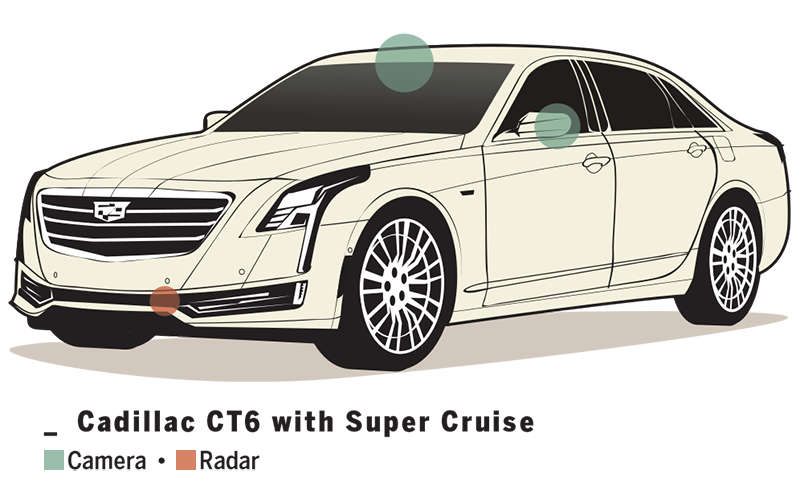
Cadillac’s challenge now is to keep the driver’s eyes and attention on the road when his hands and feet are idle. Super Cruise’s cameras and radars won’t detect a construction barrel nudged into the lane—or lined up squarely with the Cadillac crest for that matter. They won’t spot a pothole in the road, or tire tread, or any number of small objects capable of inflicting damage. That’s all on the driver.
Super Cruise’s eye-tracking camera can see through most sunglasses, but in the rare cases where it can’t, it infers eye position from the driver’s nose, mouth, and general head position. Drop your eyes to read an email or hold your phone up in front of your face, and in less than 10 seconds, Super Cruise will call on you to grab the wheel. Don’t respond, and the car will eventually begin coasting to a stop.
While Audi sees higher speeds as the larger threat, Cadillac is reluctant to take responsibility for seeing and understanding everything happening around the car. Level 3 automation at Super Cruise speeds raises the stakes exponentially and CT6 chief engineer Lyndon Lie admits that the next step is not a step at all, but a leap. If there’s an obvious way to let the driver check out at 70 or 85 mph, he’s not telling us.
If All Goes According to Plan . . .
Here are carmakers’ on-the-record timing for their automated products.
2017
_ Audi will launch Level 3 tech for use on congested highways at speeds up to 37 mph.
2020
_ Audi will build Level 4 vehicles.
_ Daimler will release Level 4 taxis in select cities “by the beginning of the next decade.”
_ Honda vehicles will have Level 3 capability for highway use.
_ Hyundai will sell vehicles with Level 3 highway capability.
_ Nissan ProPilot will offer Level 4 city driving.
_ Toyota’s Highway Teammate will deliver Level 3 capability.
2021
_ BMW will release its fully automated flagship model, iNext.
_ Ford will produce Level 4 vehicles without steering wheels or pedals for ride-hailing services.
_ Volvo will offer Level 4 cars for sale.
2025
_ Honda will offer Level 4 capability for use in most driving situations.
_ Nissan will introduce Level 5 driverless vehicles.
2030
_ Kia will put fully automated vehicles on the road.
Auto•No•Mo'•Us: Return to Full Coverage
You Might Also Like

 Yahoo Autos
Yahoo Autos 